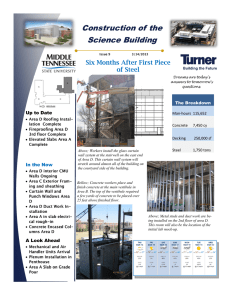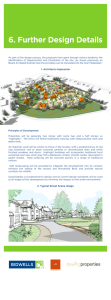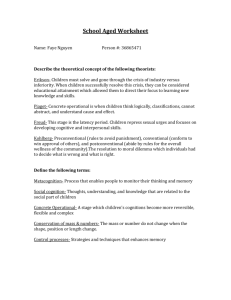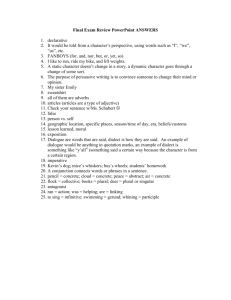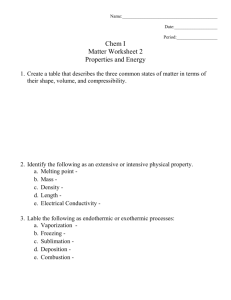HOMEWORK #7 Room Acoustics and Construction Methods
advertisement
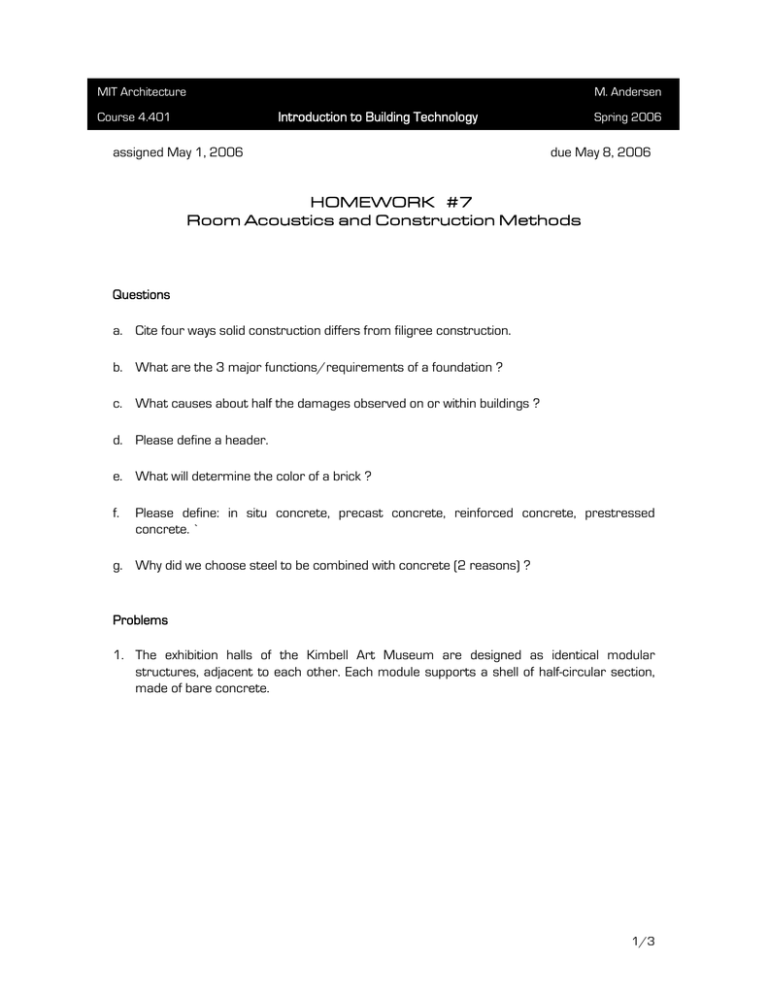
MIT Architecture M. Andersen Introduction to Building Technology Course 4.401 assigned May 1, 2006 Spring 2006 due May 8, 2006 HOMEWORK #7 Room Acoustics and Construction Methods Questions a. Cite four ways solid construction differs from filigree construction. b. What are the 3 major functions/requirements of a foundation ? c. What causes about half the damages observed on or within buildings ? d. Please define a header. e. What will determine the color of a brick ? f. Please define: in situ concrete, precast concrete, reinforced concrete, prestressed concrete. ` g. Why did we choose steel to be combined with concrete (2 reasons) ? Problems 1. The exhibition halls of the Kimbell Art Museum are designed as identical modular structures, adjacent to each other. Each module supports a shell of half-circular section, made of bare concrete. 1/3 Let’s consider one exhibition hall, consisting of a concrete, shell-sequenced ceiling (the zenithal opening and reflectors will not be accounted for in this study), concrete walls, a parquet floor and windows with large 6mm thick glass panes. The total ceiling surface is 874 m2, the total concrete walls surface is 468 m2, the windows (glass panes) cover 144 m2 and the floor 822 m2. The volume of the hall is 3500 m3. Calculate the reverberation time in this exhibition hall at a frequency of 500 Hz and comment on the following points: - what unwanted acoustic effect is likely to be provoked by the shell-shaped ceiling ? will the sound distribution be uniform ? - are the construction materials chosen for the hall rather sound-reflective or soundabsorbing ? Therefore, will they tend to extend or shorten the reverberation time ? - is the intelligibility satisfactory in this hall ? Recalculate the reverberation time if the shells were covered with an acoustic absorber such as 25 mm wood wool slabs and comment on the new acoustic conditions. 2. What kind of pore diameter would make water infiltrating a porous material up to a height of 20 cm? (assume angle α between water interface inside the pore and pore’s surface = zero). capillary constant (expressing surface tension) for water is σ = 0.073 N/m. 3. You are about to erect a part of your future masonry structure that consists of two intersecting “one-brick” walls. Draw the bonding properties of every course distinct from the one given below so that your bond fulfills the proper masonry bond requirements as faithfully as possible. Image by MIT OCW. 2/3 Design project: Instructions for the Building Relocation report What if this building had been constructed somewhere else ? For this last report, you will have to figure out what should be changed about your building if it was to be constructed in a completely different climate (in Iceland, in Saudi Arabia, in Indonesia: the relocation of your actual building is defined in the list below). More specifically, trying to maintain (or improve) the sustainability aspects of your building, you will have to address the following points: • How would you orient the building ? • What should the construction materials be ? What should the exterior envelope be made of (including insulation layers etc)? • Would you change the type, size and/or positioning of the openings ? • Would you change the arrangement of interior spaces ? • What other suggestions would you make ? What are the critical points about this building being relocated in this region ? • Overall, would you consider this relocation to be feasible for your building ? We will have an open discussion in class about your conclusions. Relocated to Saudi Arabia: Genzyme Building, Cognitive Science Building, Zesiger Center, Paul Revere House, Baker Dormitory (analysis by Ji-Hye and Joanne) Relocated to Indonesia: Carpenter Center, Kresge Auditorium (analysis by Chris and Yuliya), Simmons Hall, Boston Public Library, Stata Center Relocated to Iceland: Baker Dormitory (analysis by Shauna and Caitlin), MIT Chapel, Lobby 7, Kresge Auditorium (analysis by Emil, Chandler and Leslie) Reading relevant to lecture topics “Constructing Architecture” by Deplazes: chapters “Materials – Modules” and “Elements” "Fundamentals of Building Construction" by Allen: chapters on foundations, masonry and concrete “Building Construction Illustrated” by Ching and Adams: idem 3/3

